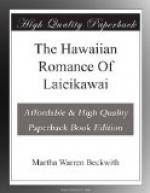is sufficiently accurate. But as regards style
the problem is much more difficult. To convey
not only the meaning but exactly the Hawaiian way of
seeing things, in such form as to get the spirit of
the original, is hardly possible to our language.
The brevity of primitive speech must be sacrificed,
thus accentuating the tedious repetition of detail—a
trait sufficiently characteristic of Hawaiian story-telling.
Then, too, common words for which we have but one
form, in the original employ a variety of synonyms.
“Say” and “see” are conspicuous
examples. Other words identical in form convey
to the Polynesian mind a variety of ideas according
to the connection in which they are used—a
play upon words impossible to translate in a foreign
idiom. Again, certain relations that the Polynesian
conceives with exactness, like those of direction
and the relation of the person addressed to the group
referred to, are foreign to our own idiom; others,
like that of time, which we have more fully developed,
the Polynesian recognizes but feebly. In face
of these difficulties the translator has reluctantly
foregone any effort to heighten the charm of the strange
tale by using a fictitious idiom or by condensing
and invigorating its deliberation. Haleole wrote
his tale painstakingly, at times dramatically, but
for the most part concerned for its historic interest.
We gather from his own statement and from the breaks
in the story that his material may have been collected
from different sources. It seems to have been
common to incorporate a
Laieikawai episode
into the popular romances, and of these episodes Haleole
may have availed himself. But we shall have something
more to say of his sources later; with his particular
style we are not concerned. The only reason for
presenting the romance complete in all its original
dullness and unmodified to foreign taste is with the
definite object of showing as nearly as possible from
the native angle the genuine Polynesian imagination
at work upon its own material, reconstructing in this
strange tale of the “Woman of the Twilight”
its own objective world, the social interests which
regulate its actions and desires, and by this means
to portray the actual character of the Polynesian
mind.
This exact thing has not before been done for Hawaiian
story and I do not recall any considerable romance
in a Polynesian tongue so rendered.[4] Admirable collections
of the folk tales of Hawaii have been gathered by
Thrum, Remy, Daggett, Emerson, and Westervelt, to which
should be added the manuscript tales collected by Fornander,
translated by John Wise, and now edited by Thrum for
the Bishop Museum, from which are drawn the examples
accompanying this paper. But in these collections
the lengthy recitals which may last several hours in
the telling or run for a couple of years as serial
in some Hawaiian newspaper are of necessity cut down
to a summary narrative, sufficiently suggesting the
flavor of the original, but not picturing fully the
way in which the image is formed in the mind of the
native story-teller. Foreigners and Hawaiians
have expended much ingenuity in rendering the mele
or chant with exactness,[5] but the much simpler if
less important matter of putting into literal English
a Hawaiian kaao has never been attempted.




